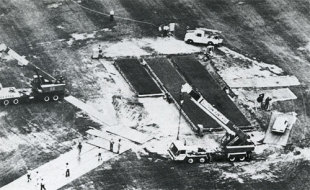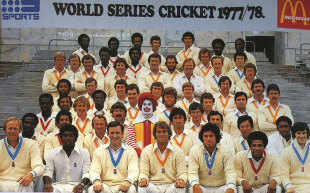
|

A drop-in pitch is manoeuvred into place at VFL Park
© The Cricketer
|
|
From May to November 1977 the cricket world was dominated by one thing - Kerry Packer and his rebel World Series Cricket project. The initial shock at the news that Packer had signed many of the world's leading players was followed by anger, recriminations, brief attempts by the establishment to find a compromise, then legal action, and finally acceptance that it would go ahead.
The Australian board, backed by other countries, did all it could to frustrate WSC. It went to court to ban organisers from referring to matches as Tests or from referring to the Australian WSC team by the national name. So Tests became Supertests and Australia became WSC Australians. The board then pulled off what it considered to be a major strike by shutting out WSC from all major cricket grounds. Packer countered by hiring other sports venues, and got his groundsmen to come up with the idea of drop-in pitches to circumvent the problems of the quality of the wickets.
In November 1977, Packer staged warm-up matches in Melbourne and Adelaide. The games went well, and enough people turned up, mainly out of curiosity, ensuring that the organisers weren't humiliated. But the real test was to come on December 2, when the competition proper got underway. Until then the fight had been about a rather detached vision. Now it was a tangible rival to the old world order.
Packer had two obvious problems. The first was that his opening clashed with the first day of the first Test between Australia and India at the Gabba. The second was that the unavailability of the MCG meant that his game had to be staged at VFL Park, a vast football stadium more than 15 miles from the heart of Melbourne.
On the eve of the matches Bobby Simpson, lured out of a decade of retirement at the age of 41 to lead an Australia side stripped of its WSC players, launched an attack on the official side, which he said had become "branded as slobs", saying that old values and discipline would be restored. Ian Chappell, one of the WSC signings, and among the chief targets of Simpson's remarks, hit back at what he called "mudslinging" adding that "Simpson is just doing all he can to downgrade the Packer series". The gloves were off.
Packer told reporters that he expected 10,000 at VFL Park to watch the first day of his Supertest between the star-packed WSC Australian and WSC West Indies sides. When the first ball was bowled, there were barely 500 people dotted around the vast banking of seats; by the close that number had only swelled to 2000. Many of those taking part had two years earlier been playing an official Test between the two countries at the MCG when 85,596 turned up. TV executives herded together children and handed them WSC merchandise to wave enthusiastically for the cameras. At the Gabba, though the weather was cold and damp, around 9000 watched the official Test.
Aside from the geographical problems posed by VFL Park, which had cost Packer A$500,000 to hire, many considered the admission of $5 too high - it was almost double what the board had charged for an official Test in 1976-77.
As far as TV viewers were concerned, the differences between the old-style Tests and WSC's new world were negligible. The kit was white, the ball red - although WSC Australians wore gold caps in contrast to the traditional Baggy Green. The quality of the coverage was the biggest difference, with Packer's Channel Nine using more cameras and more gimmicks. But the real problem was that at the Gabba a side was representing Australia; at VFL Park they were portrayed as mercenaries playing for cash.
The media, largely on the side of the ACB, wasted no time in laying into Packer, and the comments made by his players that night were in stark contrast to their bullishness in the build-up. "It's going to take a while to build this series up," Chappell said. "It could take a season or more to get it going."
"I can see how much the players love it and feel sorry that no one wants to watch," wrote former England captain Tony Lewis in the Daily Telegraph. "Only time can help, but time, too, might end it."
The drop-in pitch was also a worry, with uneven bounce, and more worryingly for the organisers, who had sold the contest as a battle between batsmen and fast bowlers, deadly slow.
If Packer thought the day could not get much worse he was to be disappointed. John Curtain, one of WSC's senior administrators, resigned in dismay at the way the event was being run. "They don't understand cricket, that's their problem," he told reporters. "The fact you buy 50 of the world's top cricketers doesn't guarantee you 50,000 or even 10 if the administration isn't good enough." Another, Chris Forsyth, was fired for spilling all to a journalist - although he was subsequently reinstated.
Packer himself, never one to shun publicity, refused to give a planned press conference and headed off into the night.
The Supertest lasted three days, with attendances marginally better at the weekend. "The crowds have been so poor," wrote John Woodcock in the Times. "With an aggregate of 13,886 [over the three days] the early finish must have been less of an embarrassment than it might have been." At the Gabba more than 32,000 had watched Simpson's Australians beat India by 16 runs in a thriller.
Packer's marketing men went on the attack, claiming that their product had been more exciting and contained more boundaries and wickets. Critics countered by saying that argument showed just how little WSC knew about the game itself.

|

World Series Cricket signings pose - with a fast-food clown - at the launch of Kerry Packer's venture
© WSC
|
|
"Twenty-two of the world's best players, a ground and a reasonable pitch are not good enough," wrote Henry Blofeld in the Guardian. "The standard of the cricket has been high enough and I have no doubt the players are trying hard, almost exaggeratedly hard as if trying to please the boss. [But] at no time did I feel the players were experiencing the genuine pressure which goes with Test cricket. In Test cricket they are playing for their places. Here it is not the same as most of them are sitting on three-year contracts."
WSC actually had a double launch on December 2. Far away from the spotlight, in Rockhampton, a second WSC Australians side took on the WSC World XI in a three-day match. With so many players contracted, the second-string signings had to be kept occupied.
If attendances at VFL Park were poor, at the Association Ground it was even worse, with barely 3000 turning up over the three days. And it wasn't as if there was no talent on show. The World XI contained Barry Richards, Mike Procter, Tony Greig, Alan Knott, Imran Khan and Zaheer Abbas; the Australians were hardly unknowns either.
Some of the players in Rockhampton had reservations. "We knew if we'd stayed with the board we'd have been golden-haired boys," said Gary Gilmour, while Kerry O'Keeffe admitted his "deep frustration" at playing in games that "Wisden was never going to record".
It was early days, and amid all the point-scoring and rhetoric, there was one voice of calm. Richie Benaud, signed as an advisor by Packer, remained philosophical. "I'm looking forward to the end of the three-year period over which costs will be judged," he said. "Any other perspective is crazy. If we are to judge the series by the first match, we must be the first multi-million dollar business which decided its future on the first week's operations."
Things did get better for Packer, although not really until his second season. In December 1977, it was the establishment that was sitting more comfortably on its laurels.
Bibliography
Cricket War by Gideon Haigh (Text, 1993)
The Cricketer
Is there an incident from the past you would like to know more about? Email us with your comments and suggestions. Martin Williamson is executive editor of Cricinfo



